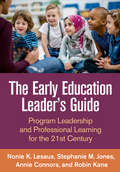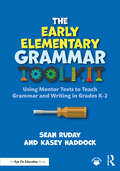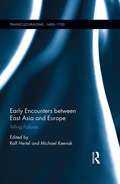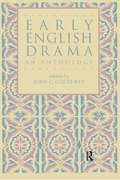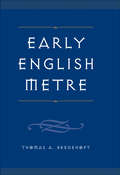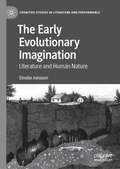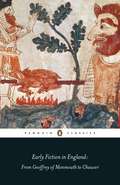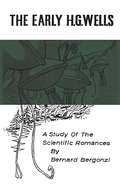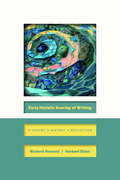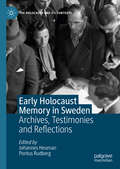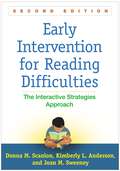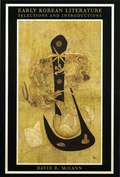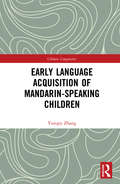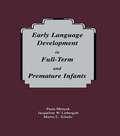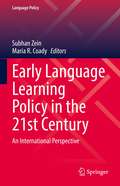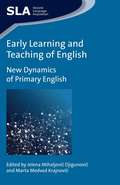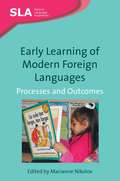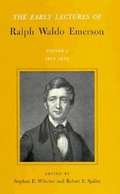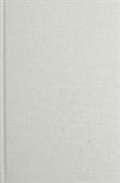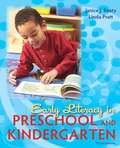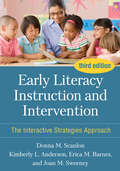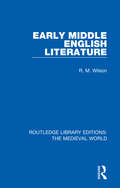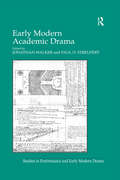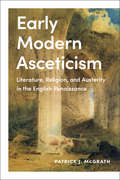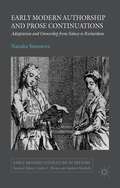- Table View
- List View
The Early Education Leader's Guide: Program Leadership and Professional Learning for the 21st Century
by Nonie K. Lesaux Stephanie M. Jones Annie Connors Robin KaneGrounded in current research and theory, this practical book guides program leaders and staff developers to design and implement engaging professional development and coaching approaches. It focuses on early educator competencies essential for high-quality learning and teaching--executive functions, emotion regulation, relationship skills, and talk for learning. Illustrated with an extended vignette of an early learning center, the book highlights how addressing educators' professional needs is a pathway to children's cognitive, social–emotional, and academic growth. User-friendly features include 24 reproducible checklists, handouts, and self-study and planning tools. Purchasers get access to a Web page where they can download and print the reproducible materials in a convenient 8 1/2" x 11" size.
The Early Elementary Grammar Toolkit: Using Mentor Texts to Teach Grammar and Writing in Grades K-2
by Sean Ruday Kasey HaddockTeaching grammar can be overwhelming and is often an overlooked part of effective instruction, especially for young learners. The Early Elementary Grammar Toolkit to the rescue! This comprehensive guide makes grammar instruction in the K–2 classroom fun and meaningful. You will learn how to: Teach grammar in a practical and applicable way by presenting each grammar rule as a useful writing tool for students. Use mentor texts—excerpts from great literature—to help students understand grammar in action. Promote metacognition along the way so that students become responsible for their own learning. Implement innovative instructional strategies and tools aligned with national and state standards. Throughout the book, you’ll find step-by-step recommendations for teaching grammatical concepts to young learners, including the use of punctuation, capitalization, parts of speech, and more. With standards-based resources and activities for grades K–2, the book includes tips addressing teaching for each of these grades, classroom snapshots that show you the tools in action, flowcharts, infographics, and specific instructional recommendations to engage students.
Early Encounters between East Asia and Europe: Telling Failures (Transculturalisms, 1400-1700)
by Ralf Hertel Michael KeevakWhile inquiries into early encounters between East Asia and the West have traditionally focused on successful interactions, this collection inquires into the many forms of failure, experienced on all sides, in the period before 1850. Countering a tendency in scholarship to overlook unsuccessful encounters, it starts from the assumption that failures can prove highly illuminating and provide valuable insights into both the specific shapes and limitations of East Asian and Western imaginations of the Other, as well as of the nature of East-West interaction. Interdisciplinary in outlook, this collection brings together the perspectives of sinology, Japanese and Korean studies, historical studies, literary studies, art history, religious studies, and performance studies. The subjects discussed are manifold and range from missionary accounts, travel reports, letters and trade documents to fictional texts as well as material objects (such as tea, chinaware, or nautical instruments) exchanged between East and West. In order to avoid a Eurocentric perspective, the collection balances approaches from the fields of English literature, Spanish studies, Neo-Latin studies, and art history with those of sinology, Japanese studies, and Korean studies. It includes an introduction mapping out the field of failures in early modern encounters between East Asia and Europe, as well as a theoretically minded essay on the lessons of failure and the ethics of cross-cultural understanding.
Early English Drama: An Anthology
by John C. ColdeweyFirst Published in 1993. Routledge is an imprint of Taylor & Francis, an informa company.
Early English Metre
by Thomas A. BredehoftThomas A. Bredehoft's Early English Metre is a reassessment of the metrical rules for English poetry from Beowulf to Layamon. Bredehoft offers a new account of many of the most puzzling features of Old English poetry - anacrusis, alliteration patterns, rhyme, and hypermetric verses - and further offers a clear account of late Old English verse as it descended from the classical verse as observed in Beowulf. He makes the surprising and controversial discovery that Ælfric?s alliterative works are formally indistinguishable from late verse.Discussing the early Middle English verse-forms of Layamon's Brut, Bredehoft not only demonstrates that they can be understood as developing from late Old English, but that Layamon seems to have known, and quoted from, the poems of the Anglo-Saxon Chronicle. Early English Metre presents a new perspective on early English verse and a new perspective on much of early English literary history. It is an essential addition to the literature on Old and Middle English and will be widely discussed amongst scholars in the field.
The Early Evolutionary Imagination: Literature and Human Nature (Cognitive Studies in Literature and Performance)
by Emelie JonssonDarwinian evolution is an imaginative problem that has been passed down to us unsolved. It is our most powerful explanation of humanity’s place in nature, but it is also more cognitively demanding and less emotionally satisfying than any myth. From the publication of the Origin of Species in 1859, evolution has pushed our capacity for storytelling into overdrive, sparking fairy tales, adventure stories, political allegories, utopias, dystopias, social realist novels, and existential meditations. Though this influence on literature has been widely studied, it has not been explained psychologically. This book argues for the adaptive function of storytelling, integrates traditional humanist scholarship with current knowledge about the evolved and adapted human mind, and calls for literary scholars to reframe their interpretation of the first authors who responded to Darwin.
Early Fiction in England: From Geoffrey of Monmouth to Chaucer
by Laura AsheA brilliant new anthology that shows how fiction was reinvented in the twelfth century after an absence of hundreds of years. Essential for all students of medieval literature, Early Fiction in England includes extracts by Geoffrey of Monmouth, Wace, Marie de France, Chaucer and many others, in new translations and with illuminating introductions. Before the twelfth century, fiction had completely disappeared in Europe. In this important and provocative book, Laura Ashe shows how English writers brought it back, composing new tales about King Arthur, his knights and other heroes and heroines in Latin, French and English. Why did fiction disappear, and why did it come to life again to establish itself the dominant form of literature ever since? And what do we even mean by the term 'fiction'? Gathering extracts from the most important texts of the period by Wace, Marie de France, Chaucer and others, this volume offers an absorbing and surprising introduction to the earliest fiction in England.The anthology includes a general introduction by Laura Ashe, introductions to each extract, explanatory notes and other useful editorial materials. All French and Latin texts have been newly translated, while Middle English texts include helpful glosses.Laura Ashe is a University Lecturer in English and Fellow of Worcester College, Oxford. Her first book Fiction and History in England, 1066-1200 (Cambridge University Press, 2007) has been followed by numerous articles and edited collections; she is now writing the newOxford English Literary History vol. 1: 1000-1350 (Oxford University Press).
The Early H.G.Wells: A Study of the Scientific Romances
by Bernard BergonziThis is a sensitive study of Wells' imaginative development during his formative years. It comes at a time when interest in H.G. Wells' early writing is beginning to revive, owing, no doubt, to the current translation into reality of some aspects of science fiction.Mr. Bergonzi examines Wells' early fiction, from surviving student writings of the late eighties to 1901 when he published The First Men in the Moon, his last significant scientific romance, and Anticipations, his first systematic non-fictional treatise. The main emphasis of his study falls on the scientific romances of the nineties, which are examined in detail. In addition to literary analysis, relevant source material and reviews, which show how contemporaries received Wells' work, are noted.Wells' early attitude to science is shown to have been deeply ambivalent, as is apparent in his successive uses of the Frankenstein archetype. His intellectual attitudes tended towards scepticism and pessimism rather than to the 'utopian' optimism associated with his later career.These romances reflect in imaginative and non-discursive form some of the major preoccupations of late-Victorian England: the impact of Darwinism, of Socialism, and an increasing lack of national self-confidence. Mr. Bergonzi sees Wells as essentially a fin de siècle myth-maker, and he argues that it is this aspect of Wells' work which most requires attention if he is to be remembered in the future. Two early pieces by Wells, now unobtainable elsewhere, are given in an Appendix. One, The Chronic Argonauts, a fragment of a fantastic novel written at the age of 21, is the earliest draft of The Time Machine.
Early Holistic Scoring of Writing: A Theory, a History, a Reflection
by Richard Haswell Norbert ElliotWhat is the most fair and efficient way to assess the writing performance of students? Although the question gained importance during the US educational accountability movement of the 1980s and 1990s, the issue had preoccupied international language experts and evaluators long before. One answer to the question, the assessment method known as holistic scoring, is central to understanding writing in academic settings. Early Holistic Scoring of Writing addresses the history of holistic essay assessment in the United Kingdom and the United States from the mid-1930s to the mid-1980s—and newly conceptualizes holistic scoring by philosophically and reflectively reinterpreting the genre’s origin, development, and significance. The book chronicles holistic scoring from its initial origin in the United Kingdom to the beginning of its heyday in the United States. Chapters cover little-known history, from the holistic scoring of school certificate examination essays written by Blitz evacuee children in Devon during WWII to teacher adaptations of holistic scoring in California schools during the 1970s. Chapters detail the complications, challenges, and successes of holistic scoring from British high-stakes admissions examinations to foundational pedagogical research by Bay Area Writing Project scholars. The book concludes with lessons learned, providing a guide for continued efforts to assess student writing through evidence models. Exploring the possibility of actionable history, Early Holistic Scoring of Writing reconceptualizes writing assessment. Here is a new history that retells the origins of our present body of knowledge in writing studies.
Early Holocaust Memory in Sweden: Archives, Testimonies and Reflections (The Holocaust and its Contexts)
by Johannes Heuman Pontus RudbergThis book investigates the memory of the Holocaust in Sweden and concentrates on early initiatives to document and disseminate information about the genocide during the late 1940s until the early 1960s. As the first collection of testimonies and efforts to acknowledge the Holocaust contributed to historical research, judicial processes, public discussion, and commemorations in the universalistic Swedish welfare state, the chapters analyse how and in what ways the memory of the Holocaust began to take shape, showing the challenges and opportunities that were faced in addressing the traumatic experiences of a minority. In Sweden, the Jewish trauma could be linked to positive rescue actions instead of disturbing politics of collaboration, suggesting that the Holocaust memory was less controversial than in several European nations following the war. This book seeks to understand how and in what ways the memory of the Holocaust began to take shape in the developing Swedish welfare state and emphasises the role of transnational Jewish networks for the developing Holocaust memory in Sweden.
Early Intervention for Reading Difficulties: The Interactive Strategies Approach
by Donna Scanlon Kimberly Anderson Joan SweeneyGrounded in a strong evidence base, this indispensable practitioner guide and text has given thousands of teachers tools to support the literacy growth of beginning and struggling readers in grades K-2. The interactive strategies approach (ISA) is organized around core instructional goals related to enhancing word learning and comprehension of text. The book provides guidance for assessment and instruction in whole-class, small-group, and one-to-one settings, using the curricular materials teachers already have.
Early Korean Literature: Selections and Introductions
by David McCannPreeminent scholar and translator David R. McCann presents an anthology of his own translations of works ranging across the major genres and authors of Korean writing—stories, legends, poems, historical vignettes, and other works—and a set of critical essays on major themes.A brief history of traditional Korean literature orients the reader to the historical context of the writings, thus bringing into focus this rich literary tradition. The anthology of translations begins with the Samguk sagi, or History of the Three Kingdoms, written in 1145, and ends with "The Story of Master Hô," written in the late 1700s. Three exploratory essays of particular subtlety and lucidity raise interpretive and comparative issues that provide a creative, sophisticated framework for approaching the selections.
Early Language Acquisition of Mandarin-Speaking Children (Chinese Linguistics)
by Yunqiu ZhangCompared with other subdisciplines in Chinese linguistics, children’s language acquisition is a significant field with relatively limited achievements. Based on data from a dynamic and developmental corpus, this book is a comprehensive exploration of the early development of Chinese-speaking children’s language acquisition. Anchoring the discussions regarding phonetics, semantics and aspects of syntax in a cognitive and functional framework, the author conducts an in-depth analysis of many acquisition characteristics, such as the inevitable and incidental errors of their learning of initials; their ability to obtain the concept of time at a young age and the utilization of Le in the expression of the past tense; their understanding of subjectivity at a young age and the ability to express it; their learning of the degree of modality following the order of from probability to necessity; and children’s acquisition of syntactic structures being impacted by genetics and also affected by the steps involved in syntactic processing. Although genetics, cognition and experience all play a role in children’s language acquisition, this book focuses on the role of cognitive functions. By successfully explaining the acquisition rules based on some cutting-edge linguistic theories, the book will certainly be beneficial to scholars studying linguistics, psychology, cognitive science and early childhood educators.
Early Language Development in Full-term and Premature infants
by Paula Menyuk Jacqueline W. Liebergott Martin C. SchultzDesigned to provide practical information to those who are concerned with the development of young children, this book has three goals. First, the authors offer details about patterns of language development over the first three years of life. Although intensive studies have been carried out by examining from one to 20 children in the age range of zero to three years, there has been no longitudinal study of a sample as large as this--53 children--nor have as many measures of language development been obtained from the same children. Examining language development from a broad perspective in this size population allows us to see what generalizations can be made about patterns of language development. This volume's second goal is to examine the impact of such factors as biology, cognition, and communication input--and the interaction of these factors--which traditionally have been held to play an important role in the course of language development. The comparative influence of each--and the interaction of all three--were examined statistically using children's scores on standard language tests at age three. The volume's third goal is to provide information to beginning investigators, early childhood educators, and clinicians that can help them in their practice. This includes information about what appear to be good early predictors of language development at three years; language assessment procedures that can be used with children below age three, how these procedures can be used, what they tell us about the language development of young children; and what warning signs should probably be attended to, and which can most likely be ignored. In addition, suggestions are made about what patterns of communicative interaction during the different periods of development seem to be most successful in terms of language development outcomes at three years, and what overall indications the study offers regarding appropriate intervention.
Early Language Learning Policy in the 21st Century: An International Perspective (Language Policy #26)
by Subhan Zein Maria R. CoadyThis volume analyses the policymaking, expectations, implementation, progress, and outcomes of early language learning in various education policy contexts worldwide. The contributors to the volume are international researchers specialising in language policy and early language learning and their contributions aim to advance scholarship on early language learning policies and inform policymaking at the global level. The languages considered include learning English as a second language in primary schools in Japan, Mexico, Serbia, Argentina, and Tanzania; Spanish language education in the US and Australia; Arabic as a second language in Israel and Bangladesh; Chinese in South America and Oceania; and finally, early German teaching and learning in France and the UK.
Early Learning and Teaching of English
by Marta Medved Krajnović Jelena Mihaljević DjigunovićThis book offers an insight into the dynamics and complexities of learning and teaching English as a foreign language at primary level. Taking a Dynamic Systems Theory perspective, the chapters present the findings of longitudinal research undertaken in Croatia into the development of English in young learners. The book includes both qualitative and quantitative research and provides insights into internal individual learner factors and external micro and macro contextual factors which impact English learner development. Importantly, it tackles the unique position of English in today's globalised world in detail. It therefore makes a major contribution to work on learning English by the digitalised generation and to understanding the impact of practices in the modern EFL classroom. The volume will appeal to anyone interested in new ways of researching the complex and dynamic phenomenon of the early learning of English.
Early Learning of Modern Foreign Languages
by Marianne NikolovModern languages are offered to young learners at an increasingly early age in many countries; yet few publications have focused on what is available to children in different contexts. This volume fills this gap by documenting the state-of-the-art in researching young language learners using a variety of research methods. It demonstrates how young children progress and benefit from an early exposure to modern languages in different educational contexts, and how affective, cognitive, social, linguistic and classroom-related factors interact in the processes. A special strength is the range of languages: although English is the most widely learnt language, chapters focus on various target languages: Croatian, French, English, German, Italian, Spanish and Ukrainian and the contexts include China, Croatia, Greece, Hungary, Ireland, Norway, Poland, the Ukraine, and the United Kingdom.
The Early Lectures of Ralph Waldo Emerson: Vol. 1 1833-1836
by Stephen E. Whicher Ralph Waldo Emerson Robert E. SpillerFamous first as a lecturer, Emerson molded his books on the rostrum. Yet, relatively few of his hundreds of lectures have ever been published. Now, in a projected series of three volumes of which this is the first, the complete surviving lectures of Emerson's earlier 'ears are made available. In a readable and critical text, these volumes will establish an important step in Emerson's creative process - that which lies between the notes jotted down in the journals and the finished text of the essays as prepared for print. The lectures, more sustained and organized than the journals and fresher and more direct than the essays, represent the vital missing middle panel in the total picture of Emerson's literary achievement. It is in the early lectures, fruits of those vigorous and formative years, that we find the first ordering of his journal thoughts. To see his mind at its most sustained activity in these crucial few ears when he was first exploring his own proper world of thought and growing with a sense of "power and hope," we need above all to have the complete, original texts of the lectures. For the years covered by this volume, all passages later published elsewhere by Emerson and others are included together with much new material. The lectures are the immediate source of much in his essays, whose composition cannot be understood without them. As important in their own right as either journals or essays, the lectures also have a coordinate interest and should be studied with the other two forms of his writing. This volume contains among others the lectures on Science, Biography, and English Literature. The editors have supplied extensive textual and informational notes, invaluable for an intelligent reading of material originally intended for oral communication.
The Early Lectures of Ralph Waldo Emerson Volume II: 1836-1838
by Ralph Waldo Emerson Robert E. Spiller Stephen E. Whicher Wallace E. WilliamsThe notable link between Emerson's journals and his essays is formed by the lectures that reflected his developing views on issues of his time. This second volume is a welcome edition of the early lectures follows the earlier experimental series of lectures and presents the works of Emerson the now professional lecturer who revealed to his audience central ideas and themes which later crystallized into Essays, First Series. The Philosophy of History, a series of 12 lectures, explores the nature of man in his society, past and present, and singles out the individual as the center of society and history. A second series of 10 lectures on Human Culture begins with the duty and the right of the individual to cultivate his powers and proceeds to consider various means by which this cultivation can be accomplished. The occasional Address on Education, which Emerson delivered between these two series, may be seen as a link between them. Of the twenty-three lectures in this volume, only three have been previously published. The lectures have been reproduced from Emerson's manuscripts, approximating as nearly as possible the original version read by the author to his audience.
Early Literacy in Preschool and Kindergarten
by Janice J. Beaty Linda PrattEarly Literacy in Preschool and Kindergarten: A Multicultural Perspective is an applied book focusing on how literacy develops in young children and the ways in which teachers can encourage the natural emergence of early reading and writing. It has a special emphasis on multicultural children's literature, including detailed descriptions of over 200 multicultural children's books. Packed with practical supports and strategies for teachers, such as how to set up a literacy-friendly environment; using music and art as natural languages; strengthening finger muscles for writing through 3-D art; developing visual representational skills in drawing, leading to writing; and using early literacy checklists to help understand children's capabilities, it provides many suggestions for using classroom materials and centers to support literacy. While most early literacy texts treat preschool learning in a chapter or two, this entire text focuses on early literacy in the preschool, leading up to children's accomplishments in kindergarten. Early Literacy in Preschool and Kindergarten: A Multicultural Perspective, Third Edition, presents an updated approach to exploring literacy with preschool and kindergarten children. The current recognition that learning to read and write can emerge naturally in young children has led the authors to develop a fresh approach by using classroom learning centers and multicultural children's literature to involve children in their own learning.
Early Literacy Instruction and Intervention: The Interactive Strategies Approach
by Donna M. Scanlon Kimberly L. Anderson Erica M. Barnes Joan M. SweeneyThis established text and teacher resource is now in a revised and updated third edition, with a broader focus on whole-class instruction as well as small-group and individualized intervention. The evidence-based Interactive Strategies Approach (ISA) provides a clear framework for supporting literacy development in grades K–3, particularly for students who experience reading difficulties. The book gives teachers the knowledge needed to more effectively use existing curricular materials to meet core instructional goals in the areas of phonemic awareness, phonics, word solving/word learning, vocabulary and language skills, and comprehension. Twenty-six reproducible forms can be copied from the book or downloaded and printed from the companion website. Of special value, the website also features approximately 200 pages of additional printable assessment tools and instructional resources. Prior edition title: Early Intervention for Reading Difficulties. New to This Edition *Increased attention to whole-class instruction, teaching linguistically diverse students, writing development, and language–literacy connections. *More examples of explicit instructional language, including sample scripts. *Incorporates the latest research about early literacy development and difficulties. *End-of-chapter "key points" and an end-of-book glossary. *Additional online-only reproducible tools, including ISA lesson sheets.
Early Middle English Literature (Routledge Library Editions: The Medieval World #53)
by R. M. WilsonOriginally published in 1939, Early Middle English Literature is a comprehensive overview of various aspects of early Middle English literature. The book examines authorship and provenance and the effect this had upon the literature of the period. This text examines literature from the period of 1066 to 1300 and addresses the transition between Old and Middle English and looks at the effect the transition of language during this period from Anglo-French to English, had on the literature of the time.
Early Modern Academic Drama (Studies in Performance and Early Modern Drama)
by Paul D. StreufertIn this essay collection, the contributors contend that academic drama represents an important, but heretofore understudied, site of cultural production in early modern England. Focusing on plays that were written and performed in academic environments such as Oxford University, Cambridge University, grammar schools, and the Inns of Court, the scholars investigate how those plays strive to give dramatic coherence to issues of religion, politics, gender, pedagogy, education, and economics. Of particular significance are the shifting political and religious contentions that so frequently shaped both the cultural questions addressed by the plays, and the sorts of dramatic stories that were most conducive to the exploration of such questions. The volume argues that the writing and performance of academic drama constitute important moments in the history of education and the theater because, in these plays, narrative is consciously put to work as both a representation of, and an exercise in, knowledge formation. The plays discussed speak to numerous segments of early modern culture, including the relationship between the academy and the state, the tensions between humanism and religious reform, the successes and failures of the humanist program, the social profits and economic liabilities of formal education, and the increasing involvement of universities in the commercial market, among other issues.
Early Modern Asceticism: Literature, Religion, and Austerity in the English Renaissance
by Patrick J. McGrathIn discussions of the works of Donne, Milton, Marvell, and Bunyan, Early Modern Asceticism shows how conflicting approaches to asceticism animate depictions of sexuality, subjectivity, and embodiment in early modern literature and religion. The book challenges the perception that the Renaissance marks a decisive shift in attitudes towards the body, sex, and the self. In early modernity, self-respect was a Satanic impulse that had to be annihilated – the body was not celebrated, but beaten into subjection – and, feeling circumscribed by sexual desire, ascetics found relief in pain, solitude, and deformity. On the basis of this austerity, Early Modern Asceticism questions the ease with which scholarship often elides the early and the modern.
Early Modern Authorship and Prose Continuations
by Natasha SimonovaThe first in-depth account of fictional sequels in the seventeenth and eighteenth centuries, this examines cases of prose fiction works being continued by multiple writers, reading them for evidence of Early Modern attitudes towards authorship, originality, and literary property.
